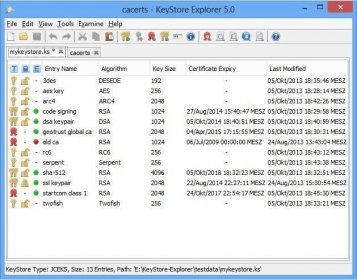

That will succesfully output a PFX File with openSSL 3.0.1. ""!OpenSSL!"" pkcs12 -export -in server.crt -inkey server.key -name MyAlias -out server_cert-and-key.pfx -legacy -passout pass:MyPassword "!OpenSSL!" x509 -req -days 365 -in server.csr -signkey server.key -out server.crtĮcho = Now export the certificate and private key to create a PFX file \server.csrĮcho = Generate self signed certificate with e.g. "!OpenSSL!" req -text -noout -verify -in. "!OpenSSL!" req -config "YourPathTo\openssl.cnf" -new -key server.key -out server.csr -sha256 -subj "/C=YourCountryShortCut/ST=YourState/L=YourTown/O=YourCompany/OU=YourOrganizationUnit/CN=YourFQDN/emailAddress=YourEmail" REM Set OPENSSL_MODULES to the path of the pack Set "OpenSslPath=YourDrive:\YourPath\openssl-3.0.1-win64" This batch sample will produce a PFX file.

Rename it to legacy.dll, otherwise it is not found. I obtained my 3.0.1 64 Windows package from. In other words, the error "Error extracting keyentry aliases from PFX" causes by version 3.0.1 this is specific to the latest version 3.0.1. Click Submit pfx The name of the -pfx file. Now you can import the file to the destination machine and configure the web server to use it. Step 3 (Optional) Scenario: I have a key file ( This post was most recently updated on April 9th, 2020 pfx, except that the shell line which created bob keytool -genkey -alias hive -keyalg RSA -keystore keystore keytool -genkey -alias hive -keyalg RSA -keystore keystore. Note: Please replace the “qqq” behind “-srcalias” with the alias, you noted in the previous step and the “xxx” behind “-deststorepass” with the password for the .jks file. The last step is now to import the certificate and its private key into the keystore by running the following command: keytool -importkeystore -srckeystore d:\cert\wildcard.pfx -srcstoretype pkcs12 -srcalias -destkeystore d:\cert\wildcard.jks -deststoretype jks -deststorepass xxx -destalias wildcard Open the file cert.txt and look for the line starting with “ Aliasname:“. To do so, run the following command: keytool -v -list -storetype pkcs12 -keystore d:\cert\wildcard.pfx > d:\cert\cert.txt In order to import the certificate, we first have to reveal the alias used. In the Certificate Export Wizard, on the Welcome page, click Next.

In the Certificates window, on the Personal tab, select your code signing certificate and then, click Export. In the Internet Options window, on the Content tab, click Certificates. In Internet Explorer, go to Internet Options. Now we import the other two CA certificates the same way: keytool -import -trustcacerts -file "d:\cert\COMODORSAAddTrustCA.crt" -alias COMODORSAAddTrustCA -keystore d:\cert\wildcard.jks -storepass xxx keytool -import -trustcacerts -file "d:\cert\COMODORSAOrganizationValidationSecureServerCA.crt" -alias COMODORSAOrganizationValidationSecureServerCA -keystore d:\cert\wildcard.jks -storepass xxx Internet Explorer: Exporting Your Code Signing Certificate as a PFX File. Note: Please replace the “xxx” behind “-storepass” with a reasonable password. Since the key store doesn’t exist, it will create it automatically: keytool -import -trustcacerts -file "d:\cert\AddTrustExternalCARoot.crt" -alias AddTrustExternalCARoot -keystore d:\cert\wildcard.jks -storepass xxx The first command puts the root CA’s certificate into the keystore. Now, we’ll use the keytool command inside the java installation folder (in my case C:\Program Files\Java\jre1.8.0_201\bin to create the keystore and put all necessary files in there. COMODORSAOrganizationValidationSecureServerCA.crt.In my case the folder contained the following files: The certificate(s) of all intermediate CAs existing in the trust chain of the certificate.The certificate of the root CA of the certificate.Copy the following files to this folder.Create a folder to collect all necessary files in.So, in order to fulfill this request, the following steps were necessary:

Since I use a Windows 10 workstation, I had to assure, that Java was installed, in my case version 1.8. It didn’t contain the certificates of the intermediate CAs.The certificate to be used had two “issues”: Recently I got the request to manually create a Java keystore (.jks) to be used on a linux-based webserver.


 0 kommentar(er)
0 kommentar(er)
